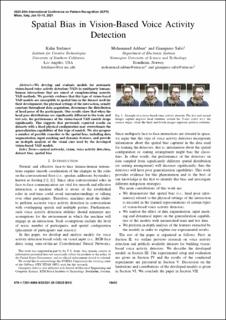| dc.contributor.author | Stefanov, Kalin | |
| dc.contributor.author | Adiban, Mohammad | |
| dc.contributor.author | Salvi, Giampiero | |
| dc.date.accessioned | 2021-09-28T06:27:02Z | |
| dc.date.available | 2021-09-28T06:27:02Z | |
| dc.date.created | 2021-03-03T11:26:29Z | |
| dc.date.issued | 2021 | |
| dc.identifier.issn | 1051-4651 | |
| dc.identifier.uri | https://hdl.handle.net/11250/2783882 | |
| dc.description.abstract | We develop and evaluate models for automatic vision-based voice activity detection (VAD) in multiparty human-human interactions that are aimed at complementing acoustic VAD methods. We provide evidence that this type of vision-based VAD models are susceptible to spatial bias in the dataset used for their development; the physical settings of the interaction, usually constant throughout data acquisition, determines the distribution of head poses of the participants. Our results show that when the head pose distributions are significantly different in the train and test sets, the performance of the vision-based VAD models drops significantly. This suggests that previously reported results on datasets with a fixed physical configuration may overestimate the generalization capabilities of this type of models. We also propose a number of possible remedies to the spatial bias, including data augmentation, input masking and dynamic features, and provide an in-depth analysis of the visual cues used by the developed vision-based VAD models. | en_US |
| dc.language.iso | eng | en_US |
| dc.publisher | Institute of Electrical and Electronics Engineers (IEEE) | en_US |
| dc.title | Spatial Bias in Vision-Based Voice Activity Detection | en_US |
| dc.type | Peer reviewed | en_US |
| dc.type | Journal article | en_US |
| dc.description.version | publishedVersion | en_US |
| dc.rights.holder | © IEEE. Personal use of this material is permitted. Permission from IEEE must be obtained for all other uses, in any current or future media, including reprinting/republishing this material for advertising or promotional purposes, creating new collective works, for resale or redistribution to servers or lists, or reuse of any copyrighted component of this work in other works. | en_US |
| dc.source.journal | IEEE Computer Society | en_US |
| dc.identifier.doi | 10.1109/ICPR48806.2021.9413345 | |
| dc.identifier.cristin | 1895227 | |
| cristin.ispublished | true | |
| cristin.fulltext | original | |
| cristin.qualitycode | 0 | |
